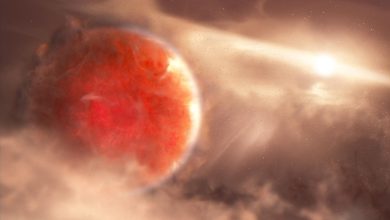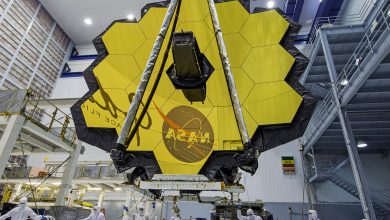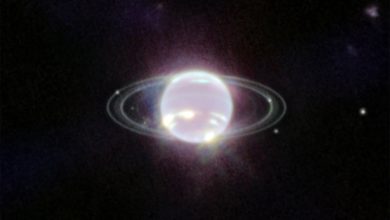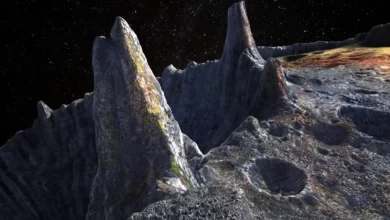
Lead Image: This illustration depicts NASA’s Perseverance rover operating on the surface of Mars. Credit: NASA
A new study based on recordings made by the rover finds that the speed of sound is slower on the Red Planet than on Earth and that, mostly, a deep silence prevails.
Listen closely to sounds from Mars, recorded by NASA’s Perseverance: the rover’s mechanical whine and click in a light Martian wind; the whir of rotors on Ingenuity, the Mars helicopter; the crackling strike of a rock-zapping laser.
An international team of scientists has done just that, performing the first analysis of acoustics on the Red Planet. Their new study reveals how fast sound travels through the extremely thin, mostly carbon dioxide atmosphere, how Mars might sound to human ears, and how scientists can use audio recordings to probe subtle air-pressure changes on another world – and to gauge the health of the rover.
The ensemble of sounds in this video captured on Mars by NASA’s Perseverance rover includes a dust removal tool for rock analysis, the Ingenuity Mars helicopter, and the impact of a laser on rocks. A new study of some of those sounds, captured mostly by the rover’s SuperCam microphone during the first 216 Martian days of the mission, reveals how sound differs on Mars, including traveling slower than on Earth. Credit: NASA/JPL-Caltech
“It’s a new sense of investigation we’ve never used before on Mars,” said Sylvestre Maurice, an astrophysicist at the University of Toulouse in France and lead author of the study. “I expect many discoveries to come, using the atmosphere as a source of sound and the medium of propagation.”
Most of the sounds in the study, published April 1, 2022, in the journal Nature, were recorded using the microphone on Perseverance’s SuperCam, mounted on the head of the rover’s mast. The study also refers to sounds recorded by another microphone mounted on the chassis of the rover. This second microphone recently recorded the puffs and pings of the rover’s Gaseous Dust Removal Tool, or gDRT, which blows shavings off rocks that the rover has scraped in order to examine.
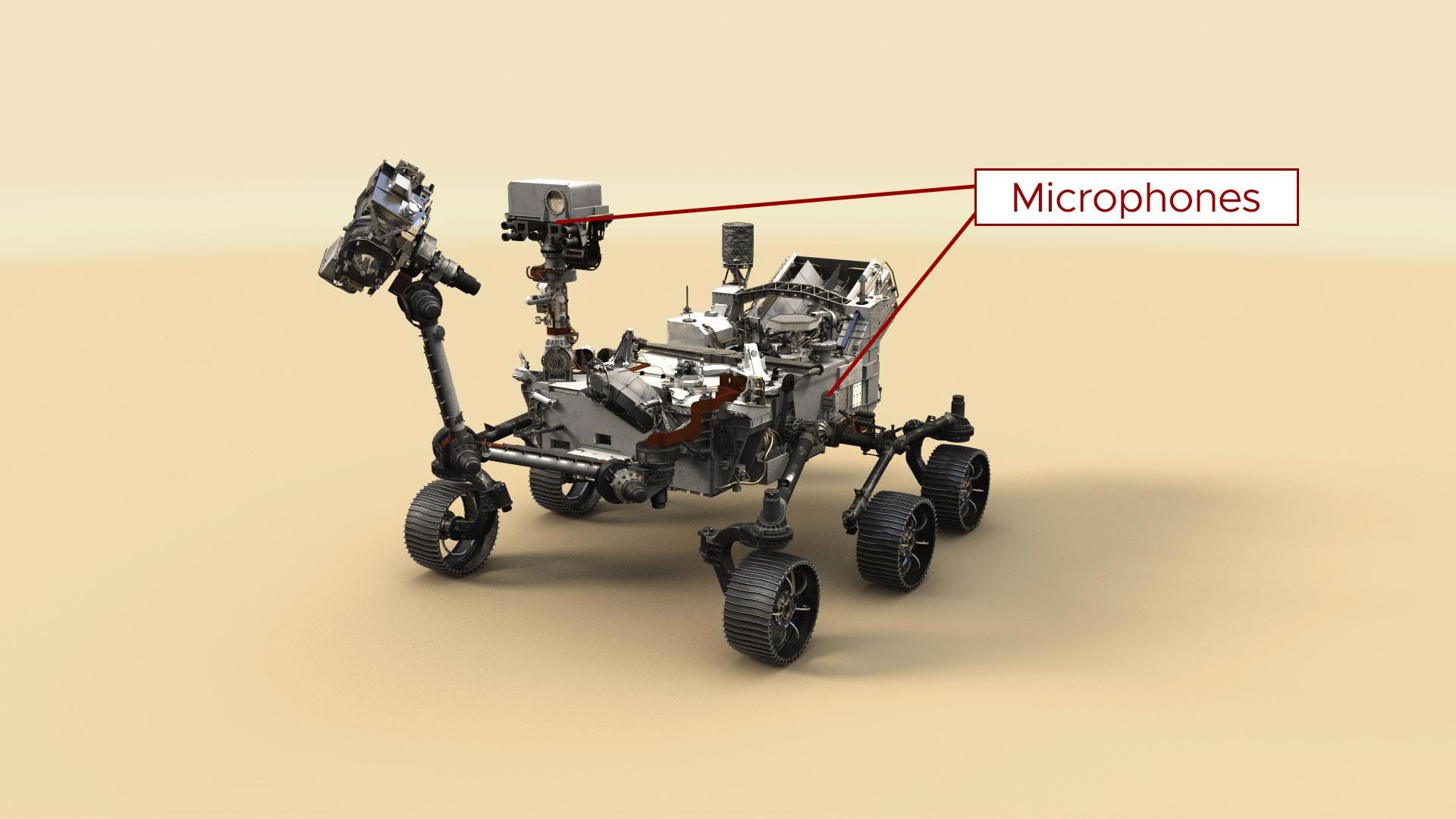
The result of the recordings: a new understanding of strange characteristics of the Martian atmosphere, where the speed of sound is slower than on Earth – and varies with pitch (or frequency). On Earth, sounds typically travel at 767 mph (343 meters per second). But on Mars, low-pitched sounds travel at about 537 mph (240 meters per second), while higher-pitched sounds move at 559 mph (250 meters per second).
The variable sound speeds on the Red Planet are an effect of the thin, cold, carbon dioxide atmosphere. Prior to the mission, scientists expected Mars’ atmosphere would influence sound speed, but the phenomenon had never been observed until these recordings were made. Another effect of this thin atmosphere: Sounds carry only a short distance, and higher-pitched tones carry hardly at all. On Earth, sound might drop off after about 213 feet (65 meters); on Mars, it falters at just 26 feet (8 meters), with high-pitched sounds being lost completely at that distance.
The recordings from SuperCam’s microphone also reveal previously unobserved pressure variations produced by turbulence in the Martian atmosphere as its energy changes at tiny scales. Martian wind gusts at very short timescales also were measured for the first time.
One of the most striking features of the sound recordings, Maurice said, is the silence that seems to prevail on Mars. “At some point, we thought the microphone was broken, it was so quiet,” he added.
That, too, is a consequence of Mars having such a thin atmosphere.
“Mars is very quiet because of low atmospheric pressure,” said Baptiste Chide of Los Alamos National Laboratory in New Mexico, also a coauthor of the study. “But the pressure changes with the seasons on Mars.”
That means, in the Martian autumn months to come, Mars might get noisier – and provide even more insights into its otherworldly air and weather.
“We are entering a high-pressure season,” Chide said. “Maybe the acoustic environment on Mars will be less quiet than it was when we landed.”
Sounds of the Mission
The acoustic team also studied what the SuperCam microphone picked up from the spinning double rotors of Ingenuity, the Mars helicopter that is the rover’s traveling companion and aerial scout. Spinning at 2,500 revolutions per minute, the rotors produce “a distinctive, low-pitched sound at 84 hertz,” Maurice said, referring to the standard acoustic measure of vibrations per second and the rotation rate for both rotors.
On the other hand, when SuperCam’s laser, which vaporizes bits of rock from a distance to study their composition, strikes a target, it makes sparks that create a high-pitched noise above 2 kilohertz.
Studying sounds recorded by the rover’s microphones not only reveals details of the Martian atmosphere, but also helps scientists and engineers assess the health and operation of the rover’s many systems, just as one might notice a troubling noise when driving a car.
Meanwhile, the key instrument in the study, SuperCam’s microphone, continues to exceed expectations.
“The microphone is now used several times a day and performs extremely well; its overall performance is better than what we had modeled and even tested in a Mars-like environment on Earth,” says David Mimoun, professor at Institut Supérieur de l’Aéronautique et de l’Espace (ISAE-SUPAERO) and lead of the team that developed the microphone experiment. “We could even record the humming of the Mars helicopter at long distance.”
Reference: “In situ recording of Mars soundscape” by S. Maurice, B. Chide, N. Murdoch, R. D. Lorenz, D. Mimoun, R. C. Wiens, A. Stott, X. Jacob, T. Bertrand, F. Montmessin, N. L. Lanza, C. Alvarez-Llamas, S. M. Angel, M. Aung, J. Balaram, O. Beyssac, A. Cousin, G. Delory, O. Forni, T. Fouchet, O. Gasnault, H. Grip, M. Hecht, J. Hoffman, J. Laserna, J. Lasue, J. Maki, J. McClean, P.-Y. Meslin, S. Le Mouélic, A. Munguira, C. E. Newman, J. A. Rodríguez Manfredi, J. Moros, A. Ollila, P. Pilleri, S. Schröder, M. de la Torre Juárez, T. Tzanetos, K. M. Stack, K. Farley, K. Williford and the SuperCam team, 1 April 2022, Nature.
DOI: 10.1038/s41586-022-04679-0
More About the Mission
A key objective for Perseverance’s mission on Mars is astrobiology, including the search for signs of ancient microbial life. The rover will characterize the planet’s geology and past climate, pave the way for human exploration of the Red Planet, and be the first mission to collect and cache Martian rock and regolith (broken rock and dust).
Subsequent NASA missions, in cooperation with ESA (European Space Agency), would send spacecraft to Mars to collect these sealed samples from the surface and return them to Earth for in-depth analysis.
The Mars 2020 Perseverance mission is part of NASA’s Moon to Mars exploration approach, which includes Artemis missions to the Moon that will help prepare for human exploration of the Red Planet.
Jet Propulsion Laboratory, which is managed for NASA by Caltech in Pasadena, California, built and manages operations of the Perseverance rover.

